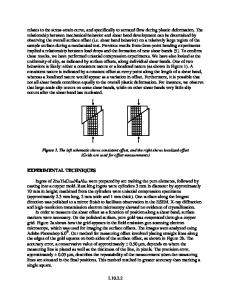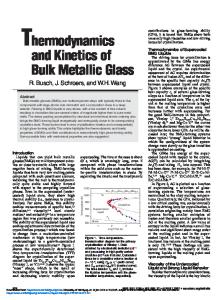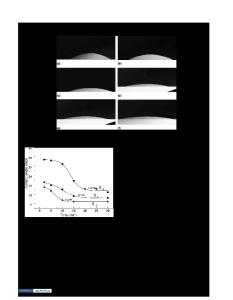Stored Mechanical Work in Inhomogeneous Deformation Processes of a Pd-Based Bulk Metallic Glass
- PDF / 356,133 Bytes
- 4 Pages / 593.972 x 792 pts Page_size
- 83 Downloads / 320 Views
etailed understanding of the response of metallic glasses to an external force is still far from complete. Generally, the deformation of such a system can be divided into elastic, anelastic, plastic behavior, and brittle fracture.[1] Depending on several external parameters, like for instance temperature, stress, strain rate, etc.,[2] metallic glasses either exhibit one of these processes dominantly or respond in a combination of them.[3–5] In the elastic regime, a material returns to its initial shape and recaptures its original structure after unloading. The time of return is from a modeling point of view instantaneous to the initial shape; however, in reality, it is given by the sound velocity. After anelastic deformation, a material preserves its original configuration, although it requires a certain relaxation time to recover. The relaxation time is determined by the internal degrees of freedom capable of storing the elastic deformation. Therefore, elastic and anelastic deformations are at least macroscopically reversible processes.[6,7] In contrast, plastic deformation is irreversible and can be divided into two different types, homogeneous and inhomogeneous plastic deformation.[7] Some time ago, the idea was established by Harmon et al.[8] that the transition from elastic and anelastic behavior to a plastic response in a metallic glass corresponds to the breakdown of the elastic matrix confinement of shear transformation zones accompanied by an
STEFAN KU¨CHEMANN, Ph.D. Student, and KONRAD SAMWER, Professor, are with the 1. Physikalisches Institut, University of Goettingen, Go¨ttingen, Germany. Contact e-mail: Stefan.Kuechemann@ phys.uni-goettingen.de HANNES WAGNER, Ph.D. Student, is with the Department of Solar Energy, Institute of Solid-State Physics, Leibniz University of Hannover, Hannover, Germany. MORITZ SCHWABE, Ph.D. Student, is with the Dr. Johannes Heidenheim GmbH, Traunreut, Germany. DENNIS BEDORF, Ph.D. Student, is with the Surface Nanometrology, Hu¨ckelhoven, Germany. WALTER ARNOLD, Professor Emeritus, is with the Department of Materials and Materials Technology, Saarland University, Saarbru¨cken, Germany. Manuscript submitted April 5, 2013. METALLURGICAL AND MATERIALS TRANSACTIONS A
Eshelby[9] stress field. This elastic matrix confinement is considered to be responsible for the anelastic behavior in metallic glasses. Furthermore, it has been shown that a certain amount of the mechanical work, which is applied to a metallic glass, is stored when the strain rate is sufficiently low so that the material can relax the applied stress by performing the so-called Johari-Goldstein or b-relaxation processes.[8] This amount can be recovered when the system is close to the glass transition temperature. The results gave evidence that below a critical stress, metallic glasses undergo reversible rearrangements, while plastic deformation above this stress leads to the dissipation of energy and therefore to a saturation in the stored enthalpy. Particularly, the shear modulus at the given strain decreases until the pla
Data Loading...











